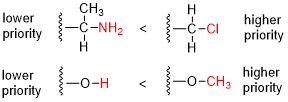
In organic chemistry, the Cahn–Ingold–Prelog (CIP) sequence rules are a standard process to completely and unequivocally name a stereoisomer of a molecule. The purpose of the CIP system is to assign an R or S descriptor to each stereocenter and an E or Z descriptor to each double bond so that the configuration of the entire molecule can be specified uniquely by including the descriptors in its systematic name. A molecule may contain any number of stereocenters and any number of double bonds, and each usually gives rise to two possible isomers. A molecule with an integer n describing the number of stereocenters will usually have 2n stereoisomers, and 2n−1 diastereomers each having an associated pair of enantiomers. The CIP sequence rules contribute to the precise naming of every stereoisomer of every organic molecule with all atoms of ligancy of fewer than 4.

Pseudoephedrine, sold under the brand name Sudafed among others, is a sympathomimetic medication which is used as a decongestant to treat nasal congestion. It has also been used off-label for certain other indications, like treatment of low blood pressure. At higher doses, it may produce various additional effects, including psychostimulant, appetite suppressant, and performance-enhancing effects. In relation to this, non-medical use of pseudoephedrine has been encountered. The medication is taken by mouth.

Ephedrine is a central nervous system (CNS) stimulant and sympathomimetic agent that is often used to prevent low blood pressure during anesthesia. It has also been used for asthma, narcolepsy, and obesity but is not the preferred treatment. It is of unclear benefit in nasal congestion. It can be taken by mouth or by injection into a muscle, vein, or just under the skin. Onset with intravenous use is fast, while injection into a muscle can take 20 minutes, and by mouth can take an hour for effect. When given by injection, it lasts about an hour, and when taken by mouth, it can last up to four hours.

Phenylpropanolamine (PPA), sold under many brand names, is a sympathomimetic agent which is used as a decongestant and appetite suppressant. It was previously commonly used in prescription and over-the-counter cough and cold preparations. The medication is taken by mouth.

Metaraminol, also known as metaradrine and sold under the brand names Aramine and Pressonex among others, is a sympathomimetic medication which is used in the prevention and treatment of hypotension, particularly as a complication of anesthesia. It is given by intramuscular or intravenous administration.
Hydroxyamphetamine may refer to:

Methoxamine, sold under the brand names Vasoxine, Vasoxyl, and Vasylox among others, is a sympathomimetic medication used as an antihypotensive agent. It has mostly or entirely been discontinued.

Gepefrine, also known as 3-hydroxyamphetamine or α-methyl-meta-tyramine and sold under the brand names Pressionorm and Wintonin, is a sympathomimetic medication used as an antihypotensive agent which has been marketed in Germany.

Cypenamine, or cypenamine hydrochloride (USAN), also known as 2-phenylcyclopentylamine, is a psychostimulant drug which was developed by a group at the William S. Merrell Chemical Company in the 1940s. It is currently known only in scientific research and has never been developed for market use. Cypenamine is currently legal throughout the entire world, and though its chemical structure has a vague similarity to certain controlled stimulants like fencamfamine, it is likely that it is too distant for it to be considered an illicit analogue under the United States Federal Analogue Act of the Controlled Substances Act.

trans-1,2-Diaminocyclohexane is an organic compound with the formula C6H10(NH2)2. This diamine is a building block for C2-symmetric ligands that are useful in asymmetric catalysis.

Pholedrine, also known as 4-hydroxy-N-methylamphetamine and sold under the brand names Paredrinol, Pulsotyl, and Veritol among others, is a sympathomimetic drug used in topical eye drops to dilate the pupil. It can be used to diagnose Horner's syndrome.
Substituted amphetamines are a class of compounds based upon the amphetamine structure; it includes all derivative compounds which are formed by replacing, or substituting, one or more hydrogen atoms in the amphetamine core structure with substituents. The compounds in this class span a variety of pharmacological subclasses, including stimulants, empathogens, and hallucinogens, among others. Examples of substituted amphetamines are amphetamine (itself), methamphetamine, ephedrine, cathinone, phentermine, mephentermine, tranylcypromine, bupropion, methoxyphenamine, selegiline, amfepramone (diethylpropion), pyrovalerone, MDMA (ecstasy), and DOM (STP).
Oxilofrine, sold under the brand names Carnigen and Suprifen among others, is a sympathomimetic medication which has been used as an antihypotensive agent and cough suppressant. It is taken by mouth.

Racephedrine, also known as racemic ephedrine and sold under the brand names Efetonina and Ephoxamine among others, is the racemic form of ephedrine which has been used as a bronchodilator to treat asthma. More specifically, it is a racemic mixture of (1R,2S)- and (1S,2R)-enantiomers. Conversely, ephedrine is the enantiopure (1R,2S)-enantiomer. Racephedrine has been marketed for medical use in Italy. Like ephedrine, racephedrine is a releasing agent of norepinephrine and to a much lesser extent of dopamine. Both ephedrine enantiomers are active in this regard, but ephedrine ( -ephedrine) has greater potency than (1S,2R)-ephedrine.

Methylephedrine, sold under the brand name Metheph among others, is a sympathomimetic medication described as an antiasthmatic agent and used to treat coughing and nasal congestion. It is reported to be used in various over-the-counter cough and cold preparations throughout the world, including Japan.

Erythrohydrobupropion is a substituted amphetamine derivative—specifically a β-hydroxyamphetamine—and a minor active metabolite of the antidepressant drug bupropion (Wellbutrin). Bupropion is a norepinephrine–dopamine reuptake inhibitor and nicotinic acetylcholine receptor negative allosteric modulator, with its metabolites contributing substantially to its activities. Erythrohydrobupropion exists as a racemic mixture of two stereoisomers, (1R,2S)-erythrohydrobupropion and (1S,2R)-erythrohydrobupropion. Other metabolites of bupropion include hydroxybupropion and threohydrobupropion.

Threohydrobupropion is a substituted amphetamine derivative—specifically a β-hydroxyamphetamine—and a major active metabolite of the antidepressant drug bupropion (Wellbutrin). Bupropion is a norepinephrine–dopamine reuptake inhibitor and nicotinic acetylcholine receptor negative allosteric modulator, with its metabolites contributing substantially to its activities.

Substituted β-hydroxyamphetamines, also known as substituted phenylisopropanolamines, substituted phenylpropanolamines, substituted norephedrines, or substituted cathinols, are derivatives of β-hydroxyamphetamine with one or more chemical substituents. They are substituted phenethylamines, phenylethanolamines (β-hydroxyphenethylamines), and amphetamines (α-methylphenethylamines), and are closely related to but distinct from the substituted cathinones (β-ketoamphetamines). Examples of β-hydroxyamphetamines include the β-hydroxyamphetamine stereoisomers phenylpropanolamine and cathine and the stereospecific N-methylated β-hydroxyamphetamine derivatives ephedrine and pseudoephedrine, among many others.

4-Fluoroephedrine (4-FEP) is a "novel psychoactive substance" and substituted β-hydroxyamphetamine derivative related to ephedrine.

Trecadrine is a drug that was originally developed as an anti-ulcer agent but was found to act as a β3-adrenergic receptor agonist with potential anti-obesity and anti-diabetic properties. It is selective for the β3-adrenergic receptor, lacking activity at the β1- and β2-adrenergic receptors. The drug is orally active. Structurally, trecadrine is a substituted β-hydroxyamphetamine and derivative of β-hydroxy-N-methylamphetamine with a tricyclic moiety attached at the amine.

















